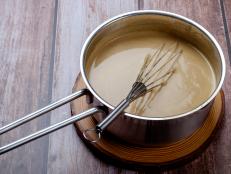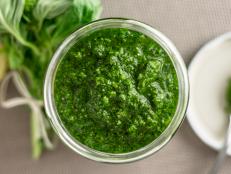How Do You Thicken Pasta Sauce?
Six easy ways to fix a runny sauce.

lewkmiller/Getty Images
By Alice K. Thompson for Food Network Kitchen
Alice is a contributing writer and editor at Food Network.
Any pasta lover has probably been there: You’re anticipating a thick, satisfying tomato sauce to coat your pasta, but what you’re seeing in the pan just isn’t there. Fortunately you’ve got a range of options for fixing it, all of them simple and most of them using pantry staples. In a few quick steps, you’ll be able to achieve the texture you’re looking for. Learn these basic techniques and you’ll even be able to repair sauces beyond tomato: gravies, cream sauces like Alfredo and more benefit from these easy kitchen interventions.
How Do You Thicken Pasta Sauce?
We focused on tomato-based sauces like marinara, Bolognese and puttanesca here, but most of these strategies work on other pasta sauces and even gravies. Just pay attention to times and flavor profiles.

FG Trade Latin/Getty Images
Cook It Down
Here’s the easiest, though not the quickest, way to thicken your sauce: Just let evaporation do its thing. Adjust the heat so it keeps the sauce at a low simmer, then leave it uncovered to cook, stirring it every 5 minutes or so. Be sure to reach the bottom and sides of the pot while stirring so nothing scorches; a heatproof rubber spatula is particularly effective. As water evaporates, your sauce will eventually thicken. In a hurry? Increasing the surface area will speed up evaporation, so putting the sauce in a wide skillet rather than a deep pan will move things along.
This method essentially condenses the sauce, however, so the flavors may intensify as the liquid evaporates. If your sauce is already quite salty or spicy, like a puttanesca, it could be better to explore the other options below.
Add Tomato Paste
Stirring in thick, dense tomato paste is a tried-and-true way to add body to a marinara or tomato sauce. Tomato paste is concentrated tomato, sometimes with small amounts of other ingredients like salt or stabilizers, and its texture is so stiff that a spoon will stand up in it. A few tablespoons may be all you need to give your sauce heft. Use a whisk to make sure the paste gets distributed well throughout the sauce, and taste the sauce after you incorporate it: Tomato paste can be very sweet, so you may want to add a little acid (like balsamic vinegar or lemon juice) and/or salt to balance your flavors.
Make a Starch Slurry
Ingredients like flour, cornstarch and arrowroot powder punch above their weight when it comes to thickening liquids. Their starch granules absorb liquid, then swell with heat to hold up to 10 times their volume. But beware: Adding a starch directly to the sauce is a recipe for both lumps and over-thickening. First, make a slurry, or a mixture of water or another liquid, and then whisk in a judicious amount, allowing it to heat for a few minutes to see if you’ve achieved your desired thickness. Try these rules for using three common starches: cornstarch, flour and arrowroot powder.
Cornstarch: Make a slurry of half water, half cornstarch and whisk until smooth. Cornstarch is a powerful thickener, so start by whisking in no more than 1 tablespoon of the mixture per 2 cups of simmering sauce; stir and simmer for 2 minutes, check the thickness, and repeat with more slurry as needed. Cornstarch will begin to break down and loose thickening power if heated too long, so introduce it to your sauce reasonably close to serving time.
Flour: Make a slurry of 2 parts water to 1 part all-purpose flour and whisk until very smooth. Slowly whisk in no more than 1 tablespoon of the mixture per 2 cups of simmering sauce. Stir and simmer for about 2 minutes, check the thickness, and repeat with more as needed. Continue simmering for at least a few more minutes to cook out the raw flour taste.
Arrowroot Powder: Make a slurry of half water, half arrowroot powder and stir until smooth. Whisk in no more than 1 tablespoon of the mixture into 2 cups of simmering sauce; stir and simmer for 2 minutes. Check the thickness and repeat as needed. As with cornstarch, arrowroot’s thickening power can decrease with long cooking, so add it as close to serving as reasonable.

annick vanderschelden photography/Getty Images
Stir in Cream
Cream will add a rich, silky element to just about any sauce and help it cling to noodles or other foods. But it will change the flavor and color of a tomato-based ones — a tomato cream sauce is lovely and delicious, but make sure it fits into your meal plan. Start by drizzling a small amount of heavy cream into the sauce and whisk it in. Let it simmer for a few minutes, then add more if you think it needs it. Taste your sauce and adjust the seasonings if needed; the richness of cream can blunt some flavors.
Add Cheese
Cheese in your sauce, not just over it as a garnish, could save your dinner. While thickening pasta sauces with cheese is more common with creamy sauces like Alfredo, it can also be used as a last-minute binder for tomato sauces. But don't expect the heavy thickening starch creates; what you’ll get is a stickier sauce that clings better and has a richer mouthfeel. Grated Parmesan is a standby because most pasta lovers have it on hand, but it’s not the only option: Small dabs of cream cheese work well, as does mascarpone, and these will be milder and less salty. Whichever cheese you choose, be sure to stir it into very hot (almost simmering) sauce and stir until combined. And stick with soft, creamy cheeses, not rubbery ones like mozzarella or fontina, unless your aim is a gooey sauce.
Add White Beans
There’s a uniquely protein-packed, plant-based way to fortify a sauce: Stir in a purée of white beans for thickness and smoothness with minimal change to the sauce’s flavor profile. First, drain and rinse the beans if they’re from a can, then blend them in a food processor or blender until very, very smooth, 2 to 3 minutes (don’t skimp on this), adding a bit of water as needed. Stir the purée into your sauce until thickened and reheat if necessary. Taste and adjust the seasoning. The sauce will be slightly lighter in color and have a heartier texture but is bound to be totally delicious, with the added benefit of extra fiber and protein.
Related Links:


























































